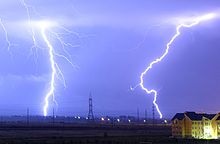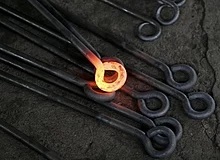|
|
| |
|
|
| |
|
|
|
|
| |
 |
| In a typical
lightning strike, 500 megajoules of electric
potential energy is converted into the same
amount of energy in other forms, mostly light
energy, sound energy and thermal energy. |
Energy
In physics, energy is the quantitative property that
must be transferred to an object in order to perform
work on, or to heat, the object. Energy is a
conserved quantity; the law of conservation of energy
states that energy can be converted in form, but not
created or destroyed. The SI unit of energy is the
joule, which is the energy transferred to an object by
the work of moving it a distance of 1 metre against a
force of 1 newton.
Common forms of energy include the kinetic energy of a
moving object, the potential energy stored by an
object's position in a force field (gravitational,
electric or magnetic), the elastic energy stored by
stretching solid objects, the chemical energy released
when a fuel burns, the radiant energy carried by light,
and the thermal energy due to an object's temperature.
Energy is a word with more than one meaning. |
- Mostly it is used in science to
describe how much potential a physical system has to
change. In physics, energy is a property of matter. It
can be transferred between objects, and converted in
form. It cannot be created or destroyed.
- It may also be used in economics to
describe the part of the market where energy itself is
harnessed and sold to consumers.
- In ordinary language, the word is
used to describe someone acting or speaking in a lively
and vigorous way.
|
|
Scientific energy
In science energy is something that can do work.
There are two basic forms of energy: |
- Kinetic energy - energy which is in
moving objects.
- Potential energy - stored energy.
|
 |
| Thermal energy is
energy of microscopic constituents of matter,
which may include both kinetic and potential
energy. |
Conservation of Energy
Energy cannot be made or destroyed, it is changed from one
form to another. The amount of energy in a closed system is
always the same. This rule is called the "conservation law
of energy".
Conservation of matter and
energy
Scientists now know that matter can be made into energy, and
energy into matter, through processes like nuclear fission
and nuclear fusion. The law of conservation of energy has
therefore been extended to become the Law of conservation of
matter and energy. Albert Einstein was the first to
mathematically derive this in the formula E = mc2.
Example
A stone is thrown upwards and falls to the ground. |
- human throws the stone: energy store
in muscles = chemical energy
- stone moves upwards = kinetic energy
- stone at the highest point =
potential energy
- stone falls to ground = kinetic
energy
- stone hits ground = thermal
energy/sonic energy
|
|
 |
| The Sun is the
source of energy for most of life on Earth. It
derives its energy mainly from nuclear fusion in
its core, converting mass to energy as protons
are combined to form helium. This energy is
transported to the sun's surface then released
into space mainly in the form of radiant (light)
energy. |
Types of energy
The total energy of a system can be subdivided and
classified in various ways. For example, classical
mechanics distinguishes between kinetic energy, which is
determined by an object's movement through space, and
potential energy, which is a function of the position of
an object within a field. It may also be convenient to
distinguish gravitational energy, thermal energy,
several types of nuclear energy (which utilize
potentials from the nuclear force and the weak force),
electric energy (from the electric field), and magnetic
energy (from the magnetic field), among others. Many of
these classifications overlap; for instance, thermal
energy usually consists partly of kinetic and partly of
potential energy.
Some types of energy are a varying mix of both potential
and kinetic energy. An example is mechanical energy
which is the sum of (usually macroscopic) kinetic and
potential energy in a system. Elastic energy in
materials is also dependent upon electrical potential
energy (among atoms and molecules), as is chemical
energy, which is stored and released from a reservoir of
electrical potential energy between electrons, and the
molecules or atomic nuclei that attract them.The list is
also not necessarily complete. Whenever physical
scientists discover that a certain phenomenon appears to
violate the law of energy conservation, new forms are
typically added that account for the discrepancy.
Heat and work are special cases in that they are not
properties of systems, but are instead properties of
processes that transfer energy. In general we cannot
measure how much heat or work are present in an object,
but rather only how much energy is transferred among
objects in certain ways during the occurrence of a given
process. Heat and work are measured as positive or
negative depending on which side of the transfer we view
them from.
Potential energies are often measured as positive or
negative depending on whether they are greater or less
than the energy of a specified base state or
configuration such as two interacting bodies being
infinitely far apart. Wave energies (such as radiant or
sound energy), kinetic energy, and rest energy are each
greater than or equal to zero because they are measured
in comparison to a base state of zero energy: "no wave",
"no motion", and "no inertia", respectively.
Examples: |
- Light energy
- Sound energy
- Renewable energy
- Solar energy
- Nuclear energy
- Elastic energy
- Gravitational potential energy
- Kinetic energy
- Dark energy
- Hamiltonian mechanics
- Internal energy
|
|
Measuring energy
Energy can be measured. The amount of energy a thing has
can be given a number.
As in other kinds of measurements, there are measurement
units. The units of measurement for measuring energy are
used to make the numbers meaningful.
Some scientific units of measurement
The SI unit for both energy and work is the joule (J).
It is named after James Prescott Joule. 1 joule is equal
to 1 newton-metre.
The energy unit of measurement for electricity is the
kilowatt-hour (kW·h). One kW·h is equivalent to
3,600,000 J (3600 kJ or 3.6 MJ) |
|
 Kiddle: Energy Kiddle: Energy
Wikipedia: Energy |
|
|
|
|
|
|
|
|
|
|
|
|
|
|
|
|
Search Fun Easy English |
|
|
|
|
|
|
|
|
|
|
|
|
|
|
|
About
Contact
Copyright
Resources
Site Map |